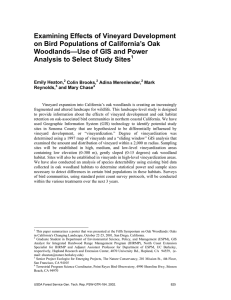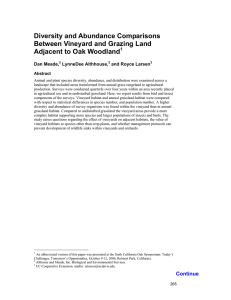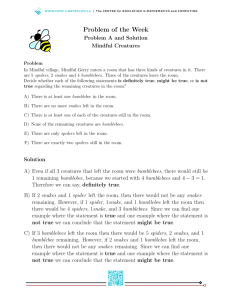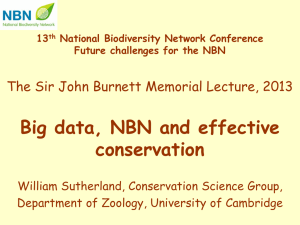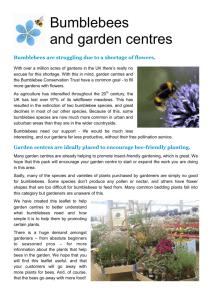Landscape Context Influences Bumble Bee Communities in Oak Woodland Habitats Gretchen LeBuhn
advertisement
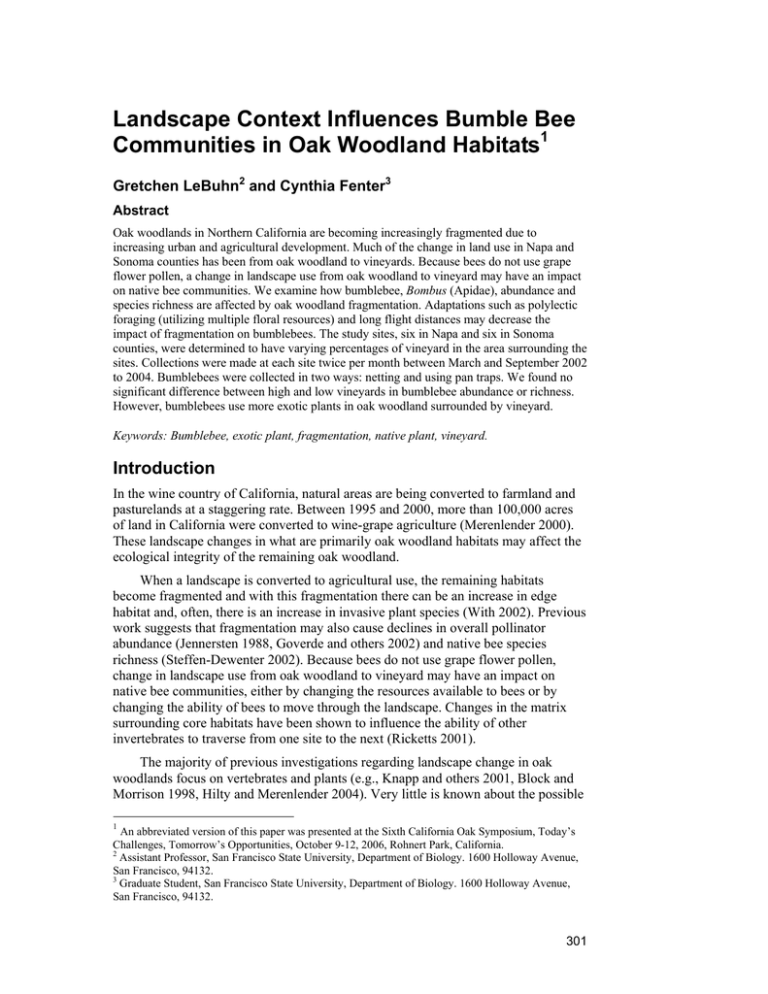
Landscape Context Influences Bumble Bee Communities in Oak Woodland Habitats1 Gretchen LeBuhn2 and Cynthia Fenter3 Abstract Oak woodlands in Northern California are becoming increasingly fragmented due to increasing urban and agricultural development. Much of the change in land use in Napa and Sonoma counties has been from oak woodland to vineyards. Because bees do not use grape flower pollen, a change in landscape use from oak woodland to vineyard may have an impact on native bee communities. We examine how bumblebee, Bombus (Apidae), abundance and species richness are affected by oak woodland fragmentation. Adaptations such as polylectic foraging (utilizing multiple floral resources) and long flight distances may decrease the impact of fragmentation on bumblebees. The study sites, six in Napa and six in Sonoma counties, were determined to have varying percentages of vineyard in the area surrounding the sites. Collections were made at each site twice per month between March and September 2002 to 2004. Bumblebees were collected in two ways: netting and using pan traps. We found no significant difference between high and low vineyards in bumblebee abundance or richness. However, bumblebees use more exotic plants in oak woodland surrounded by vineyard. Keywords: Bumblebee, exotic plant, fragmentation, native plant, vineyard. Introduction In the wine country of California, natural areas are being converted to farmland and pasturelands at a staggering rate. Between 1995 and 2000, more than 100,000 acres of land in California were converted to wine-grape agriculture (Merenlender 2000). These landscape changes in what are primarily oak woodland habitats may affect the ecological integrity of the remaining oak woodland. When a landscape is converted to agricultural use, the remaining habitats become fragmented and with this fragmentation there can be an increase in edge habitat and, often, there is an increase in invasive plant species (With 2002). Previous work suggests that fragmentation may also cause declines in overall pollinator abundance (Jennersten 1988, Goverde and others 2002) and native bee species richness (Steffen-Dewenter 2002). Because bees do not use grape flower pollen, change in landscape use from oak woodland to vineyard may have an impact on native bee communities, either by changing the resources available to bees or by changing the ability of bees to move through the landscape. Changes in the matrix surrounding core habitats have been shown to influence the ability of other invertebrates to traverse from one site to the next (Ricketts 2001). The majority of previous investigations regarding landscape change in oak woodlands focus on vertebrates and plants (e.g., Knapp and others 2001, Block and Morrison 1998, Hilty and Merenlender 2004). Very little is known about the possible 1 An abbreviated version of this paper was presented at the Sixth California Oak Symposium, Today’s Challenges, Tomorrow’s Opportunities, October 9-12, 2006, Rohnert Park, California. 2 Assistant Professor, San Francisco State University, Department of Biology. 1600 Holloway Avenue, San Francisco, 94132. 3 Graduate Student, San Francisco State University, Department of Biology. 1600 Holloway Avenue, San Francisco, 94132. 301 GENERAL TECHNICAL REPORT PSW-GTR-217 effects that vineyards have on invertebrate populations. Recent work on solitary bees in oak woodlands suggests that there is a decrease in species diversity and number of species in habitats dominated by vineyards (LeBuhn, in prep). Bumblebees (Bombus Latreille: Hymenoptera) have adaptations that may allow them to persist in areas of fragmentation. Bumblebee body mass can range (depending on species and hive duty) from 0.05g to 0.6g (Heinrich 1979). Being relatively large, bumblebees can carry more nectar and pollen longer distances that other bee genera. Bumblebees are able to warm and cool themselves using their flight muscles, consequently enabling them to fly as well as forage within a greater range of temperatures than bees that do not thermoregulate (Heinrich 1979). Bumble-bees are polylectic foragers, and therefore may make use of exotic invasive plants species that are a result of increased edges in fragmented habitats. As part of a larger study on the impact of landscape change on the flora and fauna of Napa and Sonoma counties, we examined population abundance and species richness in oak woodland wild areas surrounded by different percentages of vineyard to determine to what extent bumblebees are impacted by the surrounding vineyard matrix. We also examined whether bumblebees utilize native plants and exotic plants differentially. Methods Study Organisms Bumblebees are eusocial insects that live in colonies founded by a single overwintering queen. The queen forages for nectar and pollen in early spring to provide for her early brood members. Once the nest is established, workers take over the task of foraging for the colony through the season. In mid- to late summer, new queens and males are produced. The new males and reproductive queens leave the nest to mate, and the new queens search for appropriate quarters for hibernation. The six bumblebee species (B. vosnesneskii, B. californicus, B, sitkensis, B. melanopygus, B. bifarius, and B. flavifrons) that we observed in Napa and Sonoma counties are ground-nesting, generalist foragers that use a variety of floral resources; Bombus spp. were observed using both native and non-native plants at all sites. Sites To evaluate the abundance and species richness of bumblebees, and to determine whether there is a significant difference between native or exotic floral resource use in fragmented oak woodlands, we chose sites using aerial photographs and GIS maps of the Napa and Sonoma valleys. Potential study sites all met certain criteria for low elevation (100 to 200m) and slope (5 to 15○) to reduce variance between sites. We analyzed the percent of land that is vineyard within 1,000 m of each potential site. Surrounding areas composed of greater than 35 percent vineyard were defined as ‘high’ vineyard and areas with less than 10 percent vineyard were defined as ‘low.’ We visited each potential sampling site and included all sites that had at least 1 ha of oak woodland and that we were able to get permission to sample. Sampling We followed standard bee sampling techniques (protocols can be found at http://online.sfsu.edu/~beeplot). Within each site a 100 m2 sample plot was 302 Landscape Context Influences Bumble Bee Communities in Oak Woodland Habitats—LeBuhn established. Collections were made at each site twice per month between March and September in 2002, and between April and September 2003. Bumblebees were sampled using nets and pan traps. Preliminary data and previous monitoring studies show different colored pan traps attract different species of bee (Leong and Thorp 1999). Therefore, we used 30 plastic Solo Brand® bowls that were 5-in., 6-oz.—10 bowls each of white, blue, and yellow for each transect. The blue and yellow bowls were painted with Krylon® fluorescent paint. The bowls were divided into sets of 30 (10 of each color) and numbered so that we could randomize the order of the colors. Each bowl was placed 5m apart along two transects in each plot. The bowls were filled with a stock solution of one teaspoon of Dawn® dish detergent per gallon of water to reduce water surface tension in the pan traps. Bowls were set out between 09:00 and 15:00h. Bees caught in pan traps were pinned and identified to species. We netted bumblebees for 1 hour in the morning and 1 hour in the afternoon per sampling day. We divided each sampling plot into quadrants and netted within each quadrant for 15 minutes. The host plant type being utilized by the bee at the time of sampling was identified to species. At least one voucher specimen was taken of each bumblebee and plant to verify identification. In 2002, to assess the availability of floral resources, we identified to species (where possible) and measured the number of open flowers per sampling event to the greatest order of magnitude (1, 10, 100, 1k, 10k, 100k, 1m, 10m). Analysis To determine if there is a significant difference between ‘high’ and ‘low’ vineyard sites in bumblebee abundance and species richness, net data and pan trap data were pooled and analyzed using a two-way ANOVA using SPSS (ver. 11.5). To examine the relationship between host plant type and vineyard effect across both sampling years, we created contingency tables using Statview (ver. 5.01) Results We found 6 species of the 12 distinct species of bumblebees reported in Napa and Sonoma counties. They were from highest to lowest frequency (2002 sample / 2003 sample): B. vosnesenskii (604/210), B. californicus (49/80), B. melanopygus edwardsii (16/64), B. flavifrons (1/5), B. bifarius (0/4), and B. sitkensis 0/1). B. vosnesenskii was the most abundant species across all sites and years. There were three species on average in both high and low vineyard sites in 2002 and 2003. We had significantly higher numbers of bumblebee observations overall in 2002 (670) relative to 2003 (389). We found no difference in the richness or abundance (table 1) of bumblebees between sites surrounded primarily by vineyard and sites embedded in a natural landscape in either year. 303 GENERAL TECHNICAL REPORT PSW-GTR-217 Table 1—Two-way analysis of variance of natural log of species richness and natural log of abundance. Source Type III Sum of Squares Mean Square df F Sig. Species Richness Year Vineyard Year*Vineyard 0.001 0.007 0.171 1 1 1 0.001 0.007 0.171 0.011 0.064 0.159 0.917 0.803 0.221 Abundance Year Vineyard Year*Vineyard 1.490 2.531 0.505 1 1 1 1.490 2.531 0.505 1.674 2.843 0.567 0.210 0.107 0.460 In addition, we found that bumblebees were using native plants less frequently than exotic species in both the high and low vineyard sites in 2002 and 2003 (figure 1, 2002: X2=3.928, p-value = 0.0475, 2003: X2=7.871, p-value = 0.005 ). In 2002, there were 216 observations of bumblebees on exotic species and 57 on native species in high vineyard sites, and 294 observations of bumblebees on exotic species and 38 on native species in low vineyard sites. In 2003, there were 123 observations of bumblebees on exotic species and 47 on native species in high vineyard sites, and 96 observations of bumblebees on exotic species and 14 on native species in low vineyard sites. 1 .9 .8 .7 .6 .5 .4 .3 .2 .1 0 Exotic Native Exotic Native Figure 1—Proportion of bumblebee visits to exotic or native host plant in 2002. Striped bars are in a high vineyard environment. Solid bars are in a low vineyard environment. 304 Landscape Context Influences Bumble Bee Communities in Oak Woodland Habitats—LeBuhn Discussion Our results indicate that there was no difference in the richness or abundance of bumblebees between sites surrounded primarily by vineyard and sites embedded in a natural landscape. This is not to say that fragmentation or landscape conversion is beneficial, it only underlines how remarkably adaptive some organisms are in the face of abrupt modification of their surrounding landscape. Landscape change is one cause of fragmentation, which may decrease bee abundance and species richness (Jennersten 1988, Steffen-Dewenter and Tscharntke 2002, LeBuhn unpublished data). However, other work suggests that certain species of native bees can thrive in a fragmented landscape depending upon foraging behavior and nest site availability (Cane 2001, Steffen-Dewenter 2002). We found that the most common species, of the six that we observed, at all sites were Bombus vosnesenskii, Bombus californicus and Bombus melanopygus var. edwardsii and that there were three species on average in both ‘high’ and ‘low’ vineyard sites. On record, there are 12 distinct species of Bombus in Napa and Sonoma counties (R. Thorp pers. comm.). It may be that although there remains some contiguous wild area in these valley oak woodlands, overall species richness is low on a larger landscape scale than this study measures. McFrederick and LeBuhn (2006) found that bumblebees in urban parks in San Francisco are experiencing low species richness as compared to surrounding wild areas. This suggests that the loss of certain species in fragmented areas may be due to interspecies competition. More work on competition effects between species of bumblebees within urban parks as well as fragmented oak woodlands may uncover the effects of interspecies competition on species richness in fragmented landscapes. One explanation for bumblebees showing no marked change in numbers between sites is that they do not experience the sites as fragments. The adaptive physical and behavioral characteristics that allow bumblebees to be unaffected by landscape change may be due to their greater foraging abilities. Bombus spp. foraging distances can range from 50m to 80km in extreme cases (Mikkola 1984), with averages around 350m (Dramstad 1995, Osborne and others 1999). Davies and others (2000) found that, species that experience isolation due to fragmentation are at greater risk for declines in population. Their larger body size, thermoregulation and generalist foraging habits may allow them to nest in one fragment and find suitable host plants in a number of other fragments. Bumblebees need two resources to persist in a given habitat: floral resources and nesting sites. As relatively long-lived, generalist foragers, bumblebees are able to use a wide variety of floral resources, but those resources must persist throughout the foraging season. Interestingly, after July 1, 2002, nearly all host plants visited by bumblebees were exotic, even though 30 percent of the plants in bloom after July 1 were native (Fenter and LeBuhn in prep.). It is possible that the length of the foraging season for bumblebees may be extended artificially by these non-native plants, an unexpected positive benefit of the expansion of exotic plant species. This study does not make the claim, however, that invasive species are utilized at an equal or greater frequency than native species due to any preference, rather, that due to a greater likelihood of invasive plant species later in the season, bumblebees are utilizing these available resources. These results suggest that the biology of a particular species of Bombus will influence the response 305 GENERAL TECHNICAL REPORT PSW-GTR-217 of that species to landscape change and that there may be a correlation between foraging behavior and fitness in fragmented oak woodland. References Block, W.M; Morrison, M.L. 1998. Habitat relationships of amphibians and reptiles in California oak woodlands. J. Herpetology 32: 51-60. Cane, James H. 2001. Habitat fragmentation and native bees: A premature verdict? Conservation Ecology. Vol: 5: 3. Davies, K.F.; Margules, C.R.; Lawrence, J.F. 2000. Which traits of species predict population declines in experimental forest fragments? Ecology 81: 1450-1461. Dramstad, W.E. 1995 Do bumblebees (Hymenoptera: Apidae) really forage close to their nests? Journal of Insect Behavior. 9:163-182. Goverde, M.; Baur, B.; Erhardt, A. 2002. Small-scale habitat fragmentation effects on pollinator behavior: experimental evidence from the bumblebee Bombus veteranus on calcareous grassland. Biological Conservation 104: 293–299. Heinrich, B. 1979. Bumblebee economics. Harvard University Press. Boston. Hilty, J.; Merenlender, A. 2004. Use of riparian corridors and vineyards by mammalian predators in northern California. 18: 126-135. Jennerston, 0. 1988. Pollination in Dianthus deltoides (Caryophyllaceae): effects of habitat fragmentation on visitation and seed set. Conservation Biology 2: 359-366. Knapp, E.E.; Goedde, M.A.; Rice, K.J. 2001. Pollen-limited reproduction in bule oak: implications for wind pollination in fragmented populations. Oecologia 128: 48-55. Leong, J.M.; Thorp, R.W. 1999. Color-coded sampling: the pan trap color preferences of oligolectic and nonoligolectic bees associated with a vernal pool plant. Ecological Entomology 24: 329-335. McFrederick, Q.; LeBuhn, G. 2006. Are urban parks refuges for bumblebees, Bombus spp. (Hymenoptera: Apidae). Biological Conservation 129: 372-382. Merenlender, A.M. 2000. Mapping vineyard expansion provides information on agriculture and the environment. California Agriculture 54: 7-12. Mikkola, K. 1984. Migration of wasp and bumblebee queens across the Gulf of Finland (Hymenoptera: Vespidae and Apidae). Notulae Entomologicae 64: 125-128. Osborne, J.L.; Clark, S.J.; Morris, R.J.; Williams, I.H.; Riley, J.R.; Smith, A.D. 1999 A landscape-scale study of bumblebee foraging range and constancy, using harmonic radar. Journal of Applied Ecology, 36: 519-533. Ricketts, T.H. 2001. The matrix matters: effective isolation in fragmented landscapes. American Naturalist 158: 87-99. Steffen-Dewenter, I. 2002 Landscape context affects trap-nesting bees, wasps, and their natural enemies. Ecological Entomology 27: 631-637. Steffen-Dewenter, I.; Tscharntke, T. 2002. Insect communities and biotic interactions on fragmented calcareous grasslands-a mini review. Biological Conservation 104:275284. With, K.A. 2002. The landscape ecology of invasive spread. Conservation Biology 16:1192-1203. 306 Continue
